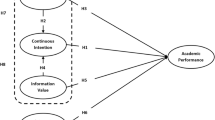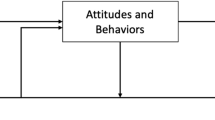Abstract
With the advent of Web 2.0, the business world is fast changing its way of communicating and collaborating. In this study, we regarded the use of instant messaging in team collaboration as a social behavior and examined the changing roles of social influence processes in the formation of usage we-intention (i.e. social intention). Building on the belief-desire-intention model and the social influence theory, an integrated model was developed and empirically tested using survey data collected from 482 students. The results demonstrated that desire partially mediates the effects of group norm and social identity on we-intention to use. In addition, the effect of group norm is more significant for users with lower usage experience, whereas the effect of social identity is more significant for users with higher usage experience. We believe this study provides several important implications for both research and practice.


Similar content being viewed by others
References
Bagozzi, R. P. (2000). On the concept of intentional social action in consumer behavior. Journal of Consumer Research, 27, 388–396.
Bagozzi, R. P. (2007). The legacy of the technology acceptance model and a proposal for a paradigm shift. Journal of the Association for Information Systems, 8(4), 244–254.
Bagozzi, R. P., & Dholakia, U. M. (2002). Intentional social action in virtual communities. Journal of Interactive Marketing, 16, 2–21.
Bagozzi, R. P., & Dholakia, U. M. (2006a). Open source software user communities: A study of participation in Linux user groups. Management Science, 52(7), 1099–1115.
Bagozzi, R. P., & Dholakia, U. M. (2006b). Antecedents and purchase consequences of customer participation in small group brand communities. International Journal of Research in Marketing, 23(1), 45–61.
Bagozzi, R. P., & Lee, K. H. (2002). Multiple routes for social influence: The role of compliance, internalization, and social identity. Social Psychology Quarterly, 65, 226–247.
Bagozzi, R., Yi, Y., & Phillips, W. (1991). Assessing construct validity in organizational research. Administrative Science Quarterly, 36, 421–458.
Baron, R. M., & Kenny, D. A. (1986). The moderator-mediator variable distinction in social psychological research: Conceptual, strategic and statistical considerations. Journal of Personality and Social Psychology, 51, 1173–1182.
Beck, R., Beimborn, D., Weitzel, T., & König, W. (2008). Network effects as drivers of individual technology adoption: Analyzing adoption and diffusion of mobile communication services. Information Systems Frontiers, 10(4), 415–429.
Bratman, M. E. (1987). Intention, plans and practical reason. Cambridge, MA: Harvard University Press.
Bratman, M. E. (1997). I Intend that We J. In G. Holmström-Hintikka & R. Tuomela (Eds.), Contemporary Action Theory. Boston: Kluwer Academic Publishers.
Cheung, C. M. K., & Lee, M. K. O. (2009). Understanding the sustainability of a virtual teacher community: an empirical investigation. Journal of Information Science, 35(3), 279–298.
Chin, W. (1998). The partial least squares approach to structural equation modeling. In G. A. Marcoulides (Ed.), Modern Methods for Business Research. NJ: Lawrence Erlbaum Associates.
Davis, F. D., Bagozzi, R. P., & Warshaw, P. R. (1989). User acceptance of computer technology: A comparison of two theoretical models. Management Science, 35, 982–1003.
Dholakia, U. M., Bagozzi, R. P., & Pearo, L. K. (2004). A social influence model of consumer participation in network- and small-group-based virtual communities. International Journal of Research in Marketing, 21, 241–263.
Dulany, D. E. (1997). Consciousness in the explicit (deliberative) and implicit (evocative). In J. D. Cohen & J. W. Schooler (Eds.), Scientific approaches to consciousness. Mahwah, NJ: Erlbaum.
Fornell, C., & Larcker, D. (1981). Evaluating structural equation models with unobservable variable and measurement error. Journal of Marketing Research, 18, 39–50.
Frankfurt, H. (1988). The importance of what we care about. Cambridge, UK: Cambridge University Press.
Gilbert, M. (1989). On Social Facts. London: Routledge.
Hair, J. F., Anderson, R. E., Tatham, R. L., & Black, W. C. (1998). Multivariate data analysis. Upper Saddle River, NJ: Prentice-Hall.
Internet World Stats. (2008). http://www.internetworldstats.com/stats.htm. Accessed 26 October 2008.
Joreskog, K. G., & Wold, H. (1982). The ML and PLS techniques for modeling with latent variables: Historical and comparative aspects. In K. G. Joreskog, & H. Wold (Eds.), Systems under indirect observation: Causality, structure, prediction.
Judd, C. M., & Kenny, D. A. (1981). Process analysis: Estimating mediation in treatment evaluations. Evaluation Review, 5, 602–619.
Karahanna, E., Straub, D. W., & Chervany, N. L. (1999). Information technology adoption across time: A cross-sectional comparison of pre-adoption and post-adoption beliefs. MIS Quarterly, 23(2), 183–213.
Keil, M., Tan, B. C. Y., Wei, K. K., & Saarinen, T. (2000). A cross-cultural study on escalation of commitment behavior in software project. MIS Quarterly, 24(2), 299–325.
Kelman, H. C. (1958). Compliance, identification, and internalization: Three processes of attitude change. Journal of Conflict Resolution, 2(1), 51–60.
Lee, M. K. O., Cheung, C. M. K., & Chen, Z. H. (2005). Acceptance of Internet-based learning medium: the role of extrinsic and intrinsic motivation. Information & Management, 42(8), 1095–1104.
Lee, M. K. O., Cheung, C. M. K., Lim, K. H., & Sia, C. L. (2006). Understanding customer knowledge sharing in web-based discussion boards - An exploratory study. Internet Research, 16(3), 289–303.
Li, D., Chau, P. Y. K., & Lou, H. (2005). Understanding individual adoption of instant messaging: An empirical investigation. Journal of the Association for Information Systems, 6(4), 102–129.
Lundberg, A. (2008). Web 2.0 in the enterprise. http://www.slideshare.net/abbielundberg/cios-web-2-0-in-the-enterprise. Accessed 4 January 2009.
Malhotra, Y., & Galletta, D. (2005). A multidimensional commitment model of volitional systems adoption and usage behavior. Journal of Management Information Systems, 22, 117–151.
McKinsey & Company. (2007). How businesses are using Web 2.0: A McKinsey global survey. http://www.finextra.com/Finextra-downloads//featuredocs/hobu07.pdf. Accessed 16 October 2008.
O’Reilly, T. (2006b). Web 2.0 compact definition: Trying again. http://radar.oreilly.com/archives/2006/12/web-20-compact-definition-tryi.html. Accessed 08 October 2008.
Obama, B. (2008). Super Tuesday speech. http://www.barackobama.com/2008/02/05/remarks_of_senator_barack_obam_46.php. Accessed 06 November 2008.
Orange, E. (2008). Collaboration - Web 2.0 the power of participation. http://www-07.ibm.com/events/nz/ibmforum/pdf/110808LotusCollaboration-Web_2_power_of_participation.pdf. Accessed 10 January 2009.
O’Reilly, T. (2005). What is Web 2.0. http://www.oreillynet.com/pub/a/oreilly/tim/news/2005/09/30/what-is-web-20.html. Accessed 8 January 2009.
O’Reilly, T. (2006a). My Commencement Speech at SIMS. http://radar.oreilly.com/archives/2006/05/my-commencement-speech-at-sims.html. Accessed 12 January 2009.
Perugini, M., & Bagozzi, R. P. (2001). The role of desires and anticipated emotions in goal-directed behavior: Broadening and deepening the theory of planned behavior. British Journal of Social Psychology, 40, 79–98.
Perugini, M., & Bagozzi, R. P. (2004). The distinction between desires and intentions. European Journal of Social Psychology, 34, 69–84.
Song, J., & Kim, Y. J. (2006). Social influence process in the acceptance of a virtual community service. Information Systems Frontiers, 8, 241–252.
Tajfel, H. (1978). Social categorization, social identity, and social comparison. In H. Tajfel (Ed.), Differentiation between social groups: Studies in the social psychology of intergroup relations. London: Academic Press.
Tan, B. C. Y., Wei, K. K., & Watson, R. T. (1998). Computer-mediated communication and majority influence: Assessing the impact of an individualistic and a collectivistic culture. Management Science, 44(9), 1263–1278.
Thompson, R., Higgins, C. A., & Howell, J. M. (1994). Influence of experience on personal computer utilization: Testing a conceptual model. Journal of Management Information Systems, 11, 167–187.
Tuomela, R. (1995). The importance of us: A philosophical study of basic social notions. Stanford, CA: Stanford University Press.
Tuomela, R. (2005). We-intention revisited. Philosophical Studies, 125(3), 327–369.
Turner, J. C. (1991). Social influence. Milton-Keynes, UK: Open University Press.
Venkatesh, V., & Davis, F. D. (2000). A theoretical extension of the technology acceptance model: Four longitudinal field studies. Management Science, 46, 186–204.
Venkatesh, V., Morris, M. G., Davis, G. B., & Davis, F. D. (2003). User acceptance of information technology: Toward a unified view. MIS Quarterly, 27, 425–478.
Wallace, D. W., Giese, J. L., & Johnson, J. L. (2004). Customer retailer loyalty in the context of multiple channel strategies. Journal of Retailing, 80(4), 249–263.
Wold, H. (1989). Introduction to the second generation of multivariate analysis. In H. Wold (Ed.), Theoretical empiricism: A general rationale for scientific model-building. New York, USA: Paragon House.
Young, G. O., Holmes, B. J., & Lawson, A. (2007). IT will measure Web 2.0 tools like any other app. http://www.forrester.com/Research/Document/Excerpt/0,7211,42814,00.html. Accessed 10 January 2009.
Acknowledgement
The work described in this article was partially supported by a grant from the Research Grant Council of the Hong Kong Special Administrative Region, China (Project No. CityU 145907).
Author information
Authors and Affiliations
Corresponding author
Appendix A. Questionnaire items
Appendix A. Questionnaire items
1.1 Subjective norm
Most people who are important to me think that I should/should not use instant messaging for team collaboration. (7-point “should-should not” scale)
Most people who are important to me would approve/disapprove of me using instant messaging for team collaboration. (7-point “approve-disapprove” scale)
1.2 Group norm
Using instant messaging for team collaboration can be considered as a goal. For each of the members in your group, please estimate the strength to which each holds the goal. (7-point “weak-strong” scales)
Strength of the shared goal by yourself
Average of the strength of the shared goal by other members
1.3 Social identity
Please indicate to what degree your self-image overlaps with the identity of the group with which you collaborate through instant messaging. (7-point “not at all-very much” scale)
How attached are you to the group with which you collaborate through instant messaging? (7-point “not at all-very much” scale)
How strong would you say your feelings of belongingness are toward the group? (7-point “not at all-very much” scale)
I am a valuable member of the group. (7-point “does not describe me at all-describes me very well” scale)
I am an important member of the group. (7-point “does not describe me at all-describes me very well” scale)
1.4 Desire
I desire to use instant messaging for team collaboration. (7-point “disagree-agree” scale)
My desire for using instant messaging in team collaboration can be described as: (7-point “no desire at all-very strong desire” scale)
I want to use instant messaging for team collaboration. (7-point “does not describe me at all-describes me very well” scale)
1.5 We-intention
I intend that our group use instant messaging for team collaboration. (7-point “disagree-agree” scale)
We intend to use instant messaging for team collaboration. (7-point “disagree-agree” scale)
Rights and permissions
About this article
Cite this article
Shen, A.X.L., Cheung, C.M.K., Lee, M.K.O. et al. How social influence affects we-intention to use instant messaging: The moderating effect of usage experience. Inf Syst Front 13, 157–169 (2011). https://doi.org/10.1007/s10796-009-9193-9
Published:
Issue Date:
DOI: https://doi.org/10.1007/s10796-009-9193-9




